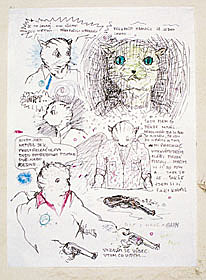| Revista Umělec 2001/3 >> The Will of the People | Lista de todas las ediciones | ||||||||||||
|
|||||||||||||
The Will of the PeopleRevista Umělec 2001/301.03.2001 Jeffrey A. Buehler | new | en cs |
|||||||||||||
|
“Everything is the Will of God.” The small, bold letters on the facade of a local bank are what greet us on our arrival in Bromouv, northern Bohemia. We have obviously come to the right place. The phrase smacks of Ivan Vosecky pith and braze, but outside spray-painted Prague the tag becomes more immediate and disturbing. Knowing that he is one of the Czech artists participating in the exhibition Criss/Cross: Praha, Stuttgart, Wroclaw, we follow the trail of Kunst to a large brewery — now gutted and dust caked — on the fringe of the center. When dealing with a three-rope tangle of nationalities out on the cutting edge of the art world’s “periphery,” it’s best to expect a few surprises. What a shame nobody warned Broumov municipality.
“Have you heard?” It’s just after the opening and most of the artists in the show are lounging out in front of the old brewery, drinking beer. “Ivan Vosecky’s been arrested for vandalism.” Absorbing this bit of information, we duck inside the spacious, cool interior of warped and sweet-smelling wood beams and trestles. The abandoned historical brewery is a perfect location for this urban invasion: with the urban public left back at home, the artworks, sheathed in the shadows, look eerie and almost poetic. Maybe it’s because the exhibition is on home territory, but it is the Czech artists who have produced the most engaging work. A swathe of purple satin by Petra Čiklová spills from ceiling to floor near the entrance and shimmers luminously in its surroundings. You have to step carefully through the room or you might wind up crunching over art, as it appears to cover every surface, including much of the floor. Most notable is Jan Šerých’s red, blue and yellow plastic bottle caps on the floor in the far corner. The whirling color design is a transient celebration of the spontaneously arranged beauty of everyday things. But ultimately for the Czechs, it is the darker side of the moon that holds the most sway. Tomáš Vaněk sprays in black paint the idyllic cutesy cartoon images of Josef Lada, the Czech artist who caricatured World War I illustrating the well-known epic soldier’s tale The Good Soldier Švejk by Jaroslav Hašek. The images would be strikingly anachronistic if it weren’t for Vaněk’s alterations, effectively depriving them of their ironic innocence. Amazing what a few tits and cocks can say about the ever-evolving identity of a place. One image he lets stand as it is, in its alien cartoon freakishness. Then there’s Josef Bolf’s enigmatic cartoon series penned in aggressive, messy strokes on eight large poster boards. The slap-dash mix of characters and images shouting balefully in English and Czech is a story of love, death and emptiness so raw in its emotion, it’s difficult to walk away without being affected by it, one way or another. The work is like a rougher Robert Crumb, even in his young psychedelic big-tits-and-ass days, less sophisticated, more desperate but just as honest. Ivan Vosecky’s stenciled strip graffito “Všechno je vůle boží” (“Everything Is the Will of God”) now looks almost laughable on the wall in the exhibition space, alone and unobtrusive, a work of art idling harmlessly where it “belongs,” up for inspection, away from accidental confrontation with the public. It could be that the real meaning of the piece is here on the wall so removed from confrontation that it lacks any meaning. The result of which has now apparently landed the artist in jail. Continuing our search of the room we discover the work of Jesper Alvaer, a Norwegian artist working in the Czech lands. He too could not resist diving into local color, only his approach was more quixotic. Newspaper articles from the past week pinned to a post detail his public search for a wife, whom he promised to marry in good faith, symbolically drawing together all the various theoretical strings behind the exhibition. His placard and stand in the central square attracted much attention but, according to Alvaer, “unfortunately there were no serious offers.” By comparison the German and Polish work seems strained and unmemorable. Kristina Fistr of Germany painted phrases for her work so ist es in all three respective languages on the wood slats of an old conveyor that runs a track up to the second floor. Lukewarm debate concludes that we still don’t know if it tells a story or not. All the way upstairs in the attic we find a horror of hanging sticky-sweet fly paper, stifling in the new July heat, by the Polish artist Marcin Mierzicki. The event was organized by the Broumov Center in an attempt to revive cultural history in an area that has historically been a crossroads between lands and peoples, and the bringing of alternative art into the region indubitably has value for all but, again, it’s too bad nobody explained all this to Broumov municipality. Word comes that Ivan Vosecký has been given a tongue lashing by the vice-mayor, who claims that the graffiti have destroyed the provincial beauty of the village. The police have ordered a massive clean up of the small, neat lettering. The court date is pending. Has the will of the people prevailed?
01.03.2001
Artículos recomendados
|
|||||||||||||









Comentarios
Actualmente no hay comentariosAgregar nuevo comentario